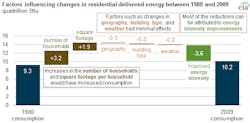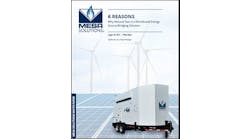The contemporary energy efficiency movement has promised we can save energy without compromising comfort – and that seems to be working according to new data from the U.S. Energy Information Administration.
American homes are getting bigger, yet we have reduced our energy intensity – a measure of energy efficiency calculated as units of energy per unit of gross domestic product.
In fact, between 1980 and 2009 we reduced our energy intensity by 37 percent. Had this not occurred, we would have used 3.9 quads more of energy in 2009, according to EIA.
We were able to save energy, even though our houses got bigger by 20 percent. And we even filled our bigger homes with bigger televisions and more computers, appliances and electronics.
So we have increased energy use more slowly than we’ve increased households. In fact, we improved energy efficiency enough to offset more than 70 percent of the growth in both the number of households and the size of the homes, according to EIA.
How did we decrease consumption and why? EIA says many factors influence how much energy we use, among them are energy prices, shifts in fuel sources, consumer preferences for increased comfort and entertainment options, and increasingly efficient technologies.
Over this time period we added more utility programs and consumer incentives to encourage energy efficiency, improved building codes, made electronics more efficient, created more residential appliance standards, and added more energy labeling.
So energy efficiency efforts are working; we’re reducing household consumption despite having more houses and bigger ones in the United States. At the same time, our homes are getting more comfortable, and we’re using more and more electric conveniences. This was the promise the energy sector offered when it made the transition away from conservation (sacrifice) to energy efficiency (better use of each unit of energy.) The promise is being fulfilled.
The full EIA report is here.






